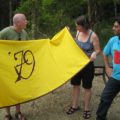Getting back to Woodstock School at the beginning of each new semester was an undertaking, and sometimes an adventure. The journey was never short: most of us lived in other countries in Asia or the Middle East. We’d take a plane or train to Delhi, then a bus or taxi to Mussoorie, 7000 feet up in the Indian Himalayas. Especially for younger students, these trips were coordinated with the school so we could be met at the airport by staff members and escorted on school-arranged buses, and more or less watched over until safely checked in at our dorms.
However, between the difficulties in communications to and within Asia 30 years ago, and the general unruliness of teenagers, the school couldn’t always keep track of everybody.
I don’t remember what year it was that I came back to Delhi after winter break and managed not to join a school party, or at least not to be on the bus with the others. It can’t have been my senior year, because a couple of kids older than myself were along on this adventure (Kim, Tajchai – do you remember this? I think you were part of this story). Somehow, five or six of us needed to get up to school, and weren’t on the school bus. None of us had much money.
There were (and are) cheap ways to travel in India, such as public long-distance bus lines (the Indian version of Greyhound) of all classes and prices, from rattling, hard-seated, overcrowded tin cans to air-conditioned “luxury” buses. But, if you were willing to stuff enough people into it to share the cost (about Rs. 500 total, if memory serves), a taxi was nearly as cheap, and at least you could ask when you needed a stop. So we pooled our resources and hired a taxi to take us from Delhi to Mussoorie, putting four in the backseat and two in the front seat (plus the driver) of a capacious Ambassador.
A taxi was more comfortable than a bus, but not by much over six or more hours of stop and go traffic on terrible roads – also very stressful driving conditions. I don’t remember what time we left Delhi, but by the time we reached Dehra Dun (the town in the valley below Mussoorie), our driver was tired, and well aware that it would take another one and a half to two hours to get us up to school. A native of India’s plains, he may also have felt daunted by the winding mountain road, falling darkness, and cold weather ahead. He decided to hand us off to a local driver in Dehra Dun for the final leg of the trip – which may have saved all our lives.
Heading up the two-lane “highway” to Mussoorie, we soon ascended into clouds, fog, and sleet. The driver went slower and slower; we could only see a few feet beyond our front bumper, then even less that that. The headlights on the taxi either hadn’t been working from the start, or failed as we were going. None of us could see anything but a dark gray fog of cloud and condensation against the car windows, but we were familiar with this road. Even though we couldn’t see it, we knew that, at many points along the way, there was no barrier to stop us plunging several hundred feet down the mountainside. Fortunately, the driver – a young local man (and a Sikh, I recall) – knew it, too.
Our group had started the day cheerful and chatty, but by now we were tired and increasingly frightened. I was nightmarishly reminded of a dim childhood memory of a similar drive up a volcano in Hawaii when I was about four.
Suddenly the car ground to a halt, crunching on roadside gravel. The driver peered out over the hood, but couldn’t see anything. He opened the door and looked down at the road. “Oh my god,” he said, quietly and hoarsely. Our front wheels were inches from a precipice.
He backed up carefully, and we continued the slow, painful journey. I don’t remember how long it took, or really anything about the trip after that point, but we obviously did eventually make it to school, and then (on foot, as ever) down to our dorms. We probably got told off for being late and not arriving with the other students.
Harrowing as it was, this wasn’t much of an adventure by Woodstock standards. Ask the students who escaped the Iranian revolution in 1979. Or the boy who, arriving home in Bombay after the partition of India in 1947, found that his parents had had to move abruptly to Lahore, and had left no forwarding address (probably didn’t know it themselves when they left). He had to make his own way, but eventually did find them, of course. Or the one who, even earlier, was home in Burma with his missionary parents for Christmas. When it was time to return to school, his father pulled out a map and said: “The Japanese are coming from here; I suggest you start walking in this [other] direction.” And he did – three weeks through the jungles with a group of missionaries fleeing the invading Japanese army, to reach Calcutta and thence take a train back to school, where he was eventually reunited with his parents.
I guess you could say that Woodstock students are resilient and know how to take care of themselves. Sometimes, we just didn’t have a choice.
. Stokes was her grandfather, a fascinating character. The only American to be arrested for participating in the struggle for India’s independence, he also introduced apples to Himachal Pradesh, where they are now a major cash crop.







